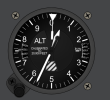Hello! I'm not sure if this is the right forum; please let me know if there's a different one where this would be more on-topic.
I wrote a simple program to practice reading analog altimeters: https://kj7rrv.com/altimeter-practice/
Does anyone have any suggestions for improvements?
I wrote a simple program to practice reading analog altimeters: https://kj7rrv.com/altimeter-practice/
Does anyone have any suggestions for improvements?

